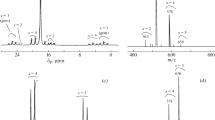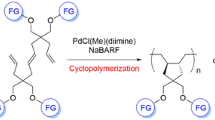Abstract
By the reaction of hexachlorocyclosphosphazene with resorcinol in the immiscible pyridine–cyclohexane system, hexa-(m-hydroxyphenoxy)cyclotriphosphazene is synthesized, the optimum yield of which of 84% is achieved in a uniform mixture of the indicated solvents and the molar ratio HCP : resorcinol = 1 : 12. When used for the synthesis of oligomers mixtures of chlorocyclophosphazenes (PNCl2)n, where n = 3, 4, and 6, also complete replacement of chlorine atoms occurs, and with a yield of up to 80%, the formation of mixed oligohydroxyphenoxycyclophosphazenes takes place. The synthesized oligomers are characterized using 31P NMR spectroscopy and MALDI-TOF mass spectrometry.
Similar content being viewed by others
Explore related subjects
Discover the latest articles, news and stories from top researchers in related subjects.Avoid common mistakes on your manuscript.
In recent years, significant progress has been made in the field of the synthesis of fire-resistant phosphazene-containing epoxy oligomers, which are synthesized either by oxidation of allyl groups in aryloxy radicals connected to phosphorus atoms or by the interaction of epichlorohydrin with hydroxy-aryloxy phosphazenes (HAP) on the basis of cyclic chlorine phase [PNCl2]3–8 and bisphenols, in particular, bisphenol A [1].
The main problem of the synthesis of HAP is the high functionality of chlorocyclophosphazenes and the propensity for partial gelation during their interaction with diphenol, even when the ratio of the starting materials is close to equipolar. Therefore, to obtain soluble HAP with a maximum degree of substitution of chlorine atoms in cyclophosphazenes, it is necessary to use a significant excess of diphenol, the separation of which from the target phosphazene polyphenols is a difficult and time-consuming task.
Synthesis of individual polyphenol P3N3(OArOH)6, where Ar is the residue of diphenylolpropane, is proposed in [2]. However, this method is multistage and does not provide an acceptable yield of the final phosphazene-containing polyphenol.
Use of sodium monophenolates of bisphenol A in a molar ratio of 1 : 12 for the reaction with hexachlorocyclotriphosphazene (HCP) leads to the formation of hexahydroxyaryloxycyclotriphosphazene containing, according to MALDI-TOF mass spectrometry, compounds with two fully or partially substituted triphosphazene rings bound by a dioxydiphenylene radical [3, 4]. Epoxidation of these polyphenols in an environment of excess epichlorohydrin in the presence of K2CO3 led to the formation of phosphazene-containing epoxy oligomers with an epoxy number of 12–13 and a phosphorus content up to 3%. Hardened with standard hardening agents for epoxy oligomers, they have a lower flammability [5].
In order to obtain HAP and phosphazene-containing epoxy oligomers based on them with a high content of phosphorus, in the present work, the interaction of HCP with resorcinol was carried out:
Dry pyridine was used as an acceptor of the resulting HCl, carrying out the reaction in the medium of which, according to 31P NMR spectra, entails the formation of the target product I with fully substituted cycles only at a molar ratio of HCP : resorcinol = 1 : 18 (Fig. 1, singlet signal δP = 9.8 ppm). The laser mass spectrum of this product (Fig. 2) demonstrates the presence in its composition of the main compound with m/z = 790, exactly corresponding to hexa(hydroxy-m-phenoxy)cyclotriphosphazene I. Low intensity signals in the region of m/z > 1300 correspond, apparently, to compounds whose molecules are constructed from two fully or partially substituted phosphazene cycles bound by dioxyphenylene bridges.
The excess of resorcinol needed to obtain product I was significantly reduced by carrying out reaction (1) in a system of two immiscible solvents, pyridine and cyclohexane [6]. Since the latter does not dissolve resorcinol, this reaction proceeds mainly in the pyridine phase with a local excess of diphenol. As can be seen from the 31P NMR spectra (see Fig. 1), the predominant formation of compound I is already observed at the molar ratio HCP : resorcinol = 1 : 8, which also agrees with the mass spectrum of MALDI-TOF (Fig. 2), in which only the trace peaks of the above-mentioned oligomers with m/z > 1300 appear.
The more equal volume ratio of pyridine–cyclohexane is optimal for carrying out the reaction in a two-phase system. With an increase in the proportion of pyridine in the solvent mixture, HAP is formed, the 31P NMR spectra of which indicate an incomplete replacement of chlorine atoms in phosphazene cycles (Fig. 3, spectrum 1).
Quantitative substitution of chlorine atoms in HCP in its interaction with resorcinol indicates the possibility of using higher chlorocyclophosphazenes or their mixtures with HCP for the synthesis of HAP.
In the present work, we used a mixture of three chlorocyclophosphazenes (a trimer, a tetramer, and a hexamer) formed during the ammonolysis of PCl5 ammonium chloride in the presence of zinc chloride [7].
The interaction of resorcinol with a mixture of these chlorocyclophosphazenes under conditions similar to those for individual HCP (equal volume mixture of pyridine–cyclohexane [PNCl2] : resorcinol = 1 : 4) leads to the formation of HAP, which according to the 31P NMR spectra (Fig. 4) consists mainly of a mixture of three fully substituted cyclic phosphazenes—trimeric (δP = 9.8 ppm), tetrameric (δP = ‒10.8 ppm), and hexameric (δP = –17.0 ppm).
31P NMR spectra of initial mixture of chlorocyclophosphazenes (PNCl2)n (1) and products of their reaction with resorcinol (2). Here and in Fig. 5, the molar ratio [NPCl2] : diphenol = 1 : 4; the volume ratio of pyridine : cyclohexane = 50 : 50.
31P NMR spectra of HAP based on a mixture of chlorocyclophosphazenes are consistent with MALDI-TOF mass spectra containing peaks of compounds PnNn(OC6H4OH)2n with n = 3, 4 and 6 (m/z = 790, 1052, 1578, respectively). Low intensity peaks in the range of values m/z = 1400–1500 can be attributed to compounds whose molecules are constructed from two trimeric phosphazene cycles linked by one (m/z = 1468) or two (m/z = 1358) dioxiphenylene radicals.
The reaction of the synthesized HAP with epichlorohydrin in the presence of alkaline agents yielded oligoepoxyphosphazenes, which have an epoxy number of up to 20%, contain 7–8% of phosphorus, and are cured with ordinary hardeners to form self-extinguishing or completely noncombustible compositions.
EXPERIMENTAL
Raw Materials
Hexachlorocyclophosphazene, a white crystalline substance (Tm = 113.0°C; 31P NMR spectrum—singlet with δP = 19.9 ppm), was obtained by the method described in [7].
A mixture of hexachlorocyclophosphazene, octachlorocyclotetraphosphazene, and dodecachlorocyclohexaphosphazene is a white or light gray powder, well soluble in organic solvents. The composition according to 31P NMR spectroscopy: 68% P3N3Cl6 (δP = 19.9 ppm); 21% P4N4Cl8 (δP = –6.6 ppm), and 11% P6N6Cl12 (δP = –15.0 ppm).
Resorcinol—white crystals (Tm = 110.8°C)—was purified by repeated recrystallization from toluene.
Pyridine was dried over KOH with the addition of a small amount of HCP and distilled at atmospheric pressure; Tb = 115.6°C.
Cyclohexane was dried with calcined CaO and at atmospheric pressure; Tb = 80.7°C.
Synthesis of Hexa-(m-hydroxyphenoxy)cyclotriphosphazene in a Mixture of Pyridine and Cyclohexane
In a three-necked flask, equipped with a mechanical stirrer, a reflux condenser, and a thermometer, 1 g (0.0029 mol) of HCP was charged and dissolved with stirring in 15 mL of cyclohexane. After complete dissolution of HCP, a solution of 3.79 g (0.0345 mol) of resorcinol in 15 mL of pyridine (HCP molar ratio : resorcinol = 1 : 12) was added. The reaction mixture was stirred at 90°C for 2 h, after which the mixture of pyridine and cyclohexane was distilled off under reduced pressure, and the residue was dissolved in glacial acetic acid and precipitated in 500 mL of water. The solid precipitate was decanted, filtered, and washed with acidified and then distilled water until neutral wash water. The product was dried under reduced pressure to constant weight.
According to chromatography mass spectrometry, compound I contains a small amount of the original resorcinol, which could not be completely removed by precipitating the acetic acid solution of the reaction mixture in a large excess of water.
The resulting substance is a white or pale yellow powder, insoluble in water and highly soluble in polar solvents. The yield of hexa-(m-hydroxyphenoxy)cyclotriphosphazene I is 1.89 g (84% of the calculated value); δP = 9.8 ppm, m/z = 790:
C | H | N | P | |
Found, %: | 55.29 | 3.74 | 5.52 | 12.10 |
Calculated for P3N3C36H24O2, %: | 54.75 | 3.80 | 5.32 | 11.78 |
Synthesis of Oligomers Based on a Mixture of Chlorocyclophosphazenes
In a three-necked flask equipped with a mechanical stirrer, a reflux condenser, and a thermometer, 1 g (0.0087 mol per NPCl2 unit) of a mixture of chlorocyclophosphazenes was loaded and dissolved with stirring in 15 mL of cyclohexane (molar ratio of NPCl2 : resorcinol = 1 : 4). After the chlorophosphazenes were completely dissolved, a solution of 3.79 g (0.0345 mol) of resorcinol in 15 mL of pyridine was poured into the resulting solution. The reaction mixture was stirred at 90°C for 2 h.
The product was isolated as described above, obtaining a white or pale yellow powder, insoluble in water and well soluble in polar solvents. The output of the mixture of oligo-(m-hydroxyphenoxy)cyclophosphazenes was 1.81 g (80.4%).
Study Methods
31P NMR and 1H NMR spectra were recorded on a Bruker AM-360 instrument at frequencies of 146 and 360 MHz, respectively. MALDI-TOF mass spectrometry analysis was performed on a Bruker Auto Flex II instrument, and quantitative determination of carbon, hydrogen, and nitrogen (configuration CHNS/O) was performed on a Thermo Flash-2000 instrument.
REFERENCES
V. V. Kireev, Y. V. Bilichenko, R. S. Borisov, I. S. Sirotin, and S. N. Filatov, Polym. Sci., Ser. B 60, 243 (2018).
I. V. Terekhov, E. M. Chistyakov, S. N. Filatov, V. V. Kireev, and R. S. Borisov, Mendeleev Commun. 24, 154 (2014).
V. V. Kireev, E. M. Chistyakov, S. N. Filatov, B. M. Prudskov, and R. S. Borisov, Polym. Sci., Ser. B 53, 412 (2011).
Yu. V. Bilichenko, V. V. Kireev, E. M. Chistyakov, V. P. Chuev, and L. L. Gapochkina, Khim. Prom-st Segodnya, No. 3, 27 (2008).
S. N. Filatov, Doctoral Dissertation in Chemistry (RKhTU im. D.I. Mendeleeva, Moscow, 2016).
US Patent No. 000001309H (1994).
I. S. Sirotin, Yu. V. Bilichenko, O. V. Suraeva, A. N. Solodukhin, and V. V. Kireev, Polym. Sci., Ser. B 55, 63 (2013).
ACKNOWLEDGMENTS
We are grateful to K.A. Brigadnov for help in the work.
Funding
This work was supported by the Federal Target Program “Research of Adhesive Materials Resistant to Cyclic Effects of High and Low Temperatures and Flame” (project 14.583.21.0056, unique identifier RFMEFI58316X0056).
Author information
Authors and Affiliations
Corresponding author
Rights and permissions
About this article
Cite this article
Bilichenko, Y.V., Nguyen, D.T., Lobova, Y.V. et al. Oligomeric Hydroxyaryloxyphosphase Based on Resorcinol. Polym. Sci. Ser. B 61, 309–313 (2019). https://doi.org/10.1134/S1560090419030023
Received:
Revised:
Accepted:
Published:
Issue Date:
DOI: https://doi.org/10.1134/S1560090419030023









